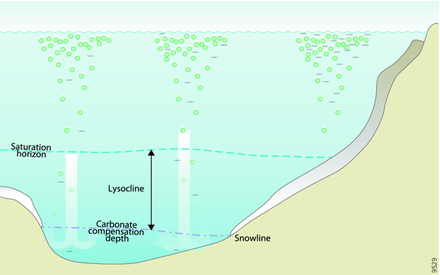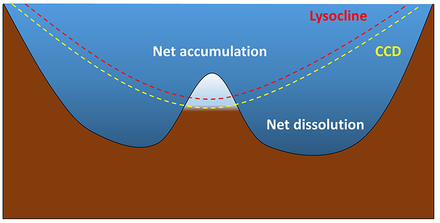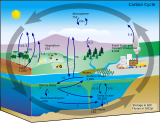The carbonate compensation depth (CCD) is the depth, in the oceans, at which the rate of supply of calcium carbonates matches the rate of solvation. That is, solvation 'compensates' supply. Below the CCD solvation is faster, so that carbonate particles dissolve and the carbonate shells (tests) of animals are not preserved. Carbonate particles cannot accumulate in the sediments where the sea floor is below this depth.
Calcite is the least soluble of these carbonates, so the CCD is normally the compensation depth for calcite. The aragonite compensation depth (ACD) is the compensation depth for aragonitic carbonates. Aragonite is more soluble than calcite, and the aragonite compensation depth is generally shallower than both the calcite compensation depth and the CCD.
Overview


As shown in the diagram, biogenic calcium carbonate (CaCO3) tests are produced in the photic zone of the oceans (green circles). Upon death, those tests escaping dissolution near the surface settle, along with clay materials. In seawater, a dissolution boundary is formed as a result of temperature, pressure, and depth, and is known as the saturation horizon. Above this horizon, waters are supersaturated and CaCO3 tests are largely preserved. Below it, waters are undersaturated, because of both the increasing solubility with depth and the release of CO2 from organic matter decay, and CaCO3 will dissolve. The sinking velocity of debris is rapid (broad pale arrows), so dissolution occurs primarily at the sediment surface.
At the carbonate compensation depth, the rate of dissolution exactly matches the rate of supply of CaCO3 from above. At steady state this depth, the CCD, is similar to the snowline (the first depth where carbonate-poor sediments occur). The lysocline is the depth interval between the saturation and carbonate compensation depths.
Solubility of carbonate
Calcium carbonate is essentially insoluble in sea surface waters today. Shells of dead calcareous plankton sinking to deeper waters are practically unaltered until reaching the lysocline, the point about 3.5 km deep past which the solubility increases dramatically with depth and pressure. By the time the CCD is reached all calcium carbonate has dissolved according to this equation:
Calcareous plankton and sediment particles can be found in the water column above the CCD. If the sea bed is above the CCD, bottom sediments can consist of calcareous sediments called calcareous ooze, which is essentially a type of limestone or chalk. If the exposed sea bed is below the CCD tiny shells of CaCO3 will dissolve before reaching this level, preventing deposition of carbonate sediment. As the sea floor spreads, thermal subsidence of the plate, which has the effect of increasing depth, may bring the carbonate layer below the CCD; the carbonate layer may be prevented from chemically interacting with the sea water by overlying sediments such as a layer of siliceous ooze or abyssal clay deposited on top of the carbonate layer.
Variations in value of the CCD
| Part of a series on the |
| Carbon cycle |
|---|
 |
| By regions |
| Carbon dioxide |
Forms of carbon
|
| Metabolic pathways |
| Carbon respiration |
| Carbon pumps |
| Carbon sequestration |
| Methane |
| Biogeochemical |
| Other |
The exact value of the CCD depends on the solubility of calcium carbonate which is determined by temperature, pressure and the chemical composition of the water – in particular the amount of dissolved CO2 in the water. Calcium carbonate is more soluble at lower temperatures and at higher pressures. It is also more soluble if the concentration of dissolved CO2 is higher. Adding a reactant to the above chemical equation pushes the equilibrium towards the right producing more products: Ca and HCO3, and consuming more reactants CO2 and calcium carbonate according to Le Chatelier's principle.
At the present time the CCD in the Pacific Ocean is about 4200–4500 metres except beneath the equatorial upwelling zone, where the CCD is about 5000 m. In the temperate and tropical Atlantic Ocean the CCD is at approximately 5000 m. In the Indian Ocean it is intermediate between the Atlantic and the Pacific at approximately 4300 meters. The variation in the depth of the CCD largely results from the length of time since the bottom water has been exposed to the surface; this is called the "age" of the water mass. Thermohaline circulation determines the relative ages of the water in these basins. Because organic material, such as fecal pellets from copepods, sink from the surface waters into deeper water, deep water masses tend to accumulate dissolved carbon dioxide as they age. The oldest water masses have the highest concentrations of CO2 and therefore the shallowest CCD. The CCD is relatively shallow in high latitudes with the exception of the North Atlantic and regions of Southern Ocean where downwelling occurs. This downwelling brings young, surface water with relatively low concentrations of carbon dioxide into the deep ocean, depressing the CCD.
In the geological past the depth of the CCD has shown significant variation. In the Cretaceous through to the Eocene the CCD was much shallower globally than it is today; due to intense volcanic activity during this period atmospheric CO2 concentrations were much higher. Higher concentrations of CO2 resulted in a higher partial pressure of CO2 over the ocean. This greater pressure of atmospheric CO2 leads to increased dissolved CO2 in the ocean mixed surface layer. This effect was somewhat moderated by the deep oceans' elevated temperatures during this period. In the late Eocene the transition from a greenhouse to an icehouse Earth coincided with a deepened CCD.
John Murray investigated and experimented on the dissolution of calcium carbonate and was first to identify the carbonate compensation depth in oceans.
Climate change impacts
See also: Effects of climate change on oceansIncreasing atmospheric concentration of CO2 from combustion of fossil fuels are causing the CCD to rise, with zones of downwelling first being affected. Ocean acidification, which is also caused by increasing carbon dioxide concentrations in the atmosphere, will increase such dissolution and shallow the carbonate compensation depth on timescales of tens to hundreds of years.
Sedimentary ooze
See also: Pelagic sedimentOn the sea floors above the carbonate compensation depth, the most commonly found ooze is calcareous ooze; on the sea floors below the carbonate compensation depth, the most commonly found ooze is siliceous ooze. While calcareous ooze mostly consists of Rhizaria, siliceous ooze mostly consists of Radiolaria and diatoms.
See also
References
- ^ Middelburg, Jack J. (2019). "Biogeochemical Processes and Inorganic Carbon Dynamics". Marine Carbon Biogeochemistry. SpringerBriefs in Earth System Sciences. pp. 77–105. doi:10.1007/978-3-030-10822-9_5. ISBN 978-3-030-10821-2. S2CID 104368944.
 Modified material was copied from this source, which is available under a Creative Commons Attribution 4.0 International License.
Modified material was copied from this source, which is available under a Creative Commons Attribution 4.0 International License.
- Webb, Paul (2019) Introduction to Oceanography, Chapter 12: Ocean Sediments, page 273–297, Rebus Community. Updated 2020.
 Modified text was copied from this source, which is available under a Creative Commons Attribution 4.0 International License.
Modified text was copied from this source, which is available under a Creative Commons Attribution 4.0 International License.
- "Ocean acidification due to increasing atmospheric carbon dioxide". The Royal Society.
- Boudreau, Bernard P.; Middelburg, Jack J.; Luo, Yiming (2018). "The role of calcification in carbonate compensation". Nature Geoscience. 11 (12): 894–900. Bibcode:2018NatGe..11..894B. doi:10.1038/s41561-018-0259-5. S2CID 135284130.
- Thurman, Harold., Alan Trujillo. Introductory Oceanography.2004.p151-152
- "Warmer than a Hot Tub: Atlantic Ocean Temperatures Much Higher in the Past". Physorg.com. February 17, 2006.
- Berger, Wolfgang H.; et al. (2016). "Calcite Compensation Depth (CCD)". Encyclopedia of Marine Geosciences. Encyclopedia of Earth Sciences Series. Springer Netherlands. pp. 71–73. doi:10.1007/978-94-007-6238-1_47. ISBN 978-94-007-6238-1.
- Sulpis, Olivier; et al. (October 29, 2018). "Current CaCO3 dissolution at the seafloor caused by anthropogenic CO2". Proceedings of the National Academy of Sciences of the United States of America. 115 (46): 11700–11705. Bibcode:2018PNAS..11511700S. doi:10.1073/pnas.1804250115. PMC 6243283. PMID 30373837.
- Boudreau, Bernard P.; Middelburg, Jack J.; Hofmann, Andreas F.; Meysman, Filip J. R. (2010). "Ongoing transients in carbonate compensation: COMPENSATION TRANSIENTS". Global Biogeochemical Cycles. 24 (4): n/a. doi:10.1029/2009GB003654. S2CID 53062358.
- Johnson, Thomas C.; Hamilton, Edwin L.; Berger, Wolfgang H. (1977-08-01). "Physical properties of calcareous ooze: Control by dissolution at depth". Marine Geology. 24 (4): 259–277. Bibcode:1977MGeol..24..259J. doi:10.1016/0025-3227(77)90071-8. ISSN 0025-3227.
- Webb, Paul (August 2023). "12.6 Sediment Distribution". Introduction to Oceanography. Retrieved 3 July 2024 – via Roger Williams University.
